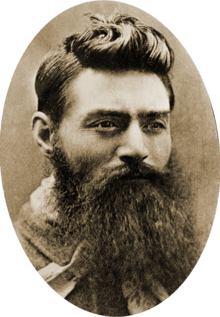Charles Nettleton
| Charles Nettleton | |
|---|---|
| Born |
1826 England |
| Died |
1902 (aged 75–76) |
| Occupation | Photographer |
Charles Nettleton (1826–1902) was an English-born photographer who worked in Victoria, Australia.[1] Nettleton used the wet plate process throughout his career.
Life
Nettleton was born in Northern England in 1826, son to George Nettleton. Looking for a change of weather of scenery, he moved to Victoria, Australia, in 1854-55, with his wife Emma Nee Miles. Together they had seven daughters and three sons.[1][2]
Nettleton was awarded the title of an official photographer during the Victorian visit of the Duke Of Edinburgh in 1867.
Nettleton became a member of the Collingwood Lodge of Freemasons in his later years and was a match-winning player for the West Melbourne Bowling Club.[1]
Career
1850s-1890s

When Nettleton arrived in Victoria, he went on to work at the photographic studio of Duryea and McDonald. On 12 September 1854, Nettleton photographed the first steam train journey in Australia, which travelled from Melbourne to Port Melbourne.[1] As a result of capturing this landmark event, Nettleton was invited to photograph the development of the railway system in Victoria.[3] He then went to work for the Victorian Government and the Melbourne Corporation.[1]
In 1858, Nettleton opened his studio. Nettleton did attempt portraiture photographs when he opened his own studio but due to poor quality, Nettleton decided to stick to his Melbourne view shots.[3]
Nettleton photographed soldiers being sent to the Maori War in 1860. In 1861, Nettleton was allowed to board the 'Great Britain' to photograph the first English cricket team to arrive in Australia.
Nettleton photographed the Artillery Camp at Sunbury in 1866.[1] In the 1860s, Nettleton became a police photographer and worked for 25 years in that department finishing his duty in the 1880s.[4] In 1880 he took a photographic portrait of Ned Kelly, the famous Australian bushranger and outlaw, the day before his execution.[1]
Nettleton decided to retire and close his studio in 1890, because of the introduction of new photography techniques.[4]
Exhibitions
1860s
In the 1860s, Nettleton was becoming known as a photographer. Nettleton created photograph albums and those photographs were shown in a few exhibitions. Nettleton's first successful exhibition was presented in London in 1862.[1] Other exhibitions took place in Dublin in 1865 and Paris in 1867.[4]
1870s
His final exhibition was in his home country, Australia. In 1879, Nettleton's photographs were shown in a Sydney Exhibition.[4]
Techniques
Nettleton used the wet plate process for his images. Also referred to as collodion process.[4] The new process of the dry plate was being used substantially by the general public in 1885. This new technique of photography had given Nettleton a tough time with his wet plate process and eventually he settled on retirement five years after it was generalised to the public. The dry plate process was afflicting on Nettleton.
Nettleton knew how to capture a photograph professionally, as he was able to adjust complicating structures with his knowledge of great depth of field. Nettleton created clear detail within his photographs.
Nettleton's photos had a sharp delineation taken at six second exposure.[1] Using this technique he was able to photograph the soldiers and horses in the Maori War and capture them as still photographs.[3]
Photography
Nettletons photo collections are kept at major institutions around Australia.[4]
In 1868, Nettleton published the first souvenir albums for the public in Australia. His album was made up of views of Melbourne that contained 12 photographs.[2] As well as his album, Nettleton designed large album prints of his views of shipping in the mid to late 1880s. These views included The Queen's Wharf, the Drops at Caliban waterworks and the waterworks at Geelong, Malmsbury and Yean Yan. As there was no photo-mechanical printing processes, all of Nettleton's albums are of his real photographs. These albums can be found in libraries and museums in Australia.
Nettletons prints were of two sizes; 8 × 6 and 15 × 12.[3]
His photography was of the urban views and local scenery, and included public buildings, forests, the water and sewerage system, bridges, roads, country towns, wharves, diversion of the Yarra River, the construction of the Botanical Gardens and his famous collection of ships, including the Cutty Shark and the Shenandoah. Nettleton was so dedicated to his work that he would even go to disaster areas to photograph them.[1]
Nettleton went to the highest points he could reach and took panoramas.[3] One of these panoramas was used as the basis for a lithograph by De Gruchy and Leigh.[2]
References
- 1 2 3 4 5 6 7 8 9 10 Gittins, Jean (13 April 2015). "Nettleton, Charles (1826-1902)". Australian Dictionary Of Biography. Retrieved 13 April 2015.
- 1 2 3 Newton, Gael (1988). Shades Of Light. Canberra: Australian National Gallery. pp. 38–44.
- 1 2 3 4 5 Cato, Jack (1977). The Story Of The Camera In Australia (2nd ed.). Institute Of Australian Photography. pp. 29–33.
- 1 2 3 4 5 6 "Photograph Album- 'Melbourne Photographs', Charles Nettleton, Melbourne, Victoria, 1890s". Museum Victoria. Retrieved 19 April 2015.